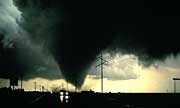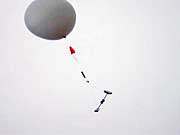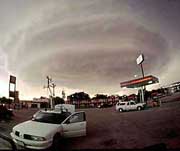
skip to content program navigation
| Learn more about these WEATHER RESEARCH areas... |
Field Experiments
NOAA Research scientists use field observations to test their theories. The atmosphere is a complex, dynamic system with motions on many scales. Scientists use equations and computers to model the atmosphere, but cannot be certain their ideas are sound until they can prove them through observation.
Special Instruments
When NOAA scientists go into the field, they are often looking for specific processes, like how tornadoes form or how electricity discharges in clouds. Special instruments and sensors, often designed specifically for the task, are taken into the field to study the weather. Because instruments and equipment can be costly to fabricate and maintain, OAR scientists share resources with other researchers. Collaboration with other scientists and the sharing of collected data are fundamental to the success of most field observing programs.
Testing Theories
Sometimes field observations lead back to theoretical studies, as was the case with VORTEX, conducted by the National Severe Storms Laboratory. Scientists, who had often seen cloud bases changing in a particular way before a tornado formed, began to think about the kinds of processes that could cause the change. These observations led, in part, to several tornadogenesis hypotheses being debated and tested today.
Analyzing Data
Analysis of detailed data sets such as those collected by innovative mobile and deployable field observing systems provides invaluable knowledge to scientists seeking to understand the dynamics of weather. The difficult work of integrating these unique data sets into coherent pictures of storm structure is an ongoing process and essential to NOAA's research effort.
Recent major field projects undertaken by OAR scientists include:
TELEX
In spring and early summer of 2003 and 2004, researchers and student assistants scrambled to get in position beneath storms in central Oklahoma to launch instrumented weather balloons. The Thunderstorm Electrification and Lightning Experiment involved scientists from the National Severe Storms Laboratory and the University of Oklahoma. They combined forces to study thunderstorms and lightning, with the ultimate goal of using lightning observations to improve forecasts and warnings of hazardous weather. Scientists gathered data on the storms using a variety of sensors, including weather balloons, Doppler weather radar with polarimetric technology, mobile Doppler radars, and a lightning mapping network.
IHOP
The International H2O Project involved more than 80 scientists from the U.S., France, Germany, the Netherlands and Canada who focused their efforts on the southern Great Plains in 2002. The weather field project was designed to obtain more accurate and reliable measurements of moisture in the air. Scientists used NEXRAD radars, NOAA's wind profiler network and temporary wind and humidity measuring instruments. Radars, lidars and radiometers were installed on research aircraft, deployed at a fixed site or mounted onto cars and trucks.
STEPS
In summer 2000, during the Severe Thunderstorm Electrification and Precipitation Study, scientists targeted supercell thunderstorms, long-lived storms with deep rotating updrafts that are common on the high plains of northwest Kansas, eastern Colorado and southwest Nebraska. Each day, researchers focused on one supercell storm. A T-28 armored aircraft penetrated the target storm to collect data on cloud particles and the electric field. Researchers launched balloons from severe mobile sounding systems, while mobile ground units and mobile mesonet vehicles took measurements. Data was also gathered using a network of three Doppler radars, two dual-polarization radars, and a deployable lightning mapping system.
The Dimmitt, TX tornado was "captured" during the Verification of the Origin of Rotation in Thunderstorms Experiment (VORTEX). By documenting the tornado from beginning to end, researchers were later able to analyze the data to help them understand more about tornado formation. Photo by Harald Richter.
Scientists gathered storm data using weather balloons launched from mobile atmospheric laboratories during TELEX. The instrument train consists of a parachute, a GPS radiosonde, and an electric field meter for determining the electrical structure of storms. Photo by Ken Eack.
The STEPS researchers fuel up one of the mobile mesonets while tracking this supercell thunderstorm during the STEPS project. A mobile mesonet is a vehicle outfitted with roof-mounted instruments and sensors that measure atmospheric conditions in the near-storm environment. |
NOAA Research programs
that participate in Field Experiments
 National
Severe Storms Laboratory
National
Severe Storms Laboratory
 Earth
System Research Laboratory
Earth
System Research Laboratory
Additional Related Information



